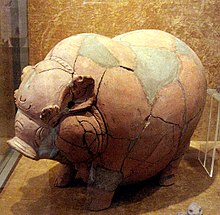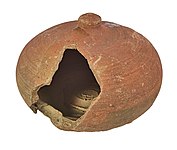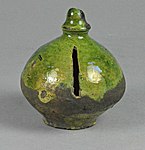Piggy bank


Piggy bank (sometimes penny bank or money box) is the traditional name of a coin container normally used by children. The piggy bank is known to collectors as a "still bank" as opposed to the "mechanical banks" popular in the early 20th century. These items are also often used by companies for promotional purposes, and many financial service companies use piggy banks as logos for their savings products.
Piggy banks are usually made of
Origins

The oldest Western find of a money box dates from the 2nd century BC
Pig-shaped money box

The earliest known pig-shaped money containers date to the 12th century on the island of Java. The Javanese term cèlèngan (ꦕꦺꦭꦺꦁꦔꦤ꧀; literally "likeness of a wild boar",[n 1] but used to mean both "savings" and "piggy bank") is also in the modern Indonesian language.
A large number of boar-shaped piggy banks were discovered at the large archaeological site surrounding Trowulan, a village in the Indonesian province of East Java and a possible site of the capital of the Majapahit Empire.[5]
There are some
Uses
The general use of piggy banks is to store loose change in a quaint, decorative manner. Modern piggy banks are not limited to the likeness of pigs and may come in a range of shapes, sizes, and colors. They are most commonly used by temples and churches because they are locked money boxes with narrow openings to drop cash or coins. The box is opened via a plug underneath it at regular intervals when the collected money is counted and recorded.
See also
Image gallery
-
Money box from the Southern Song dynasty (1127–1279).
-
Broken money box in red earthenware (between 1250 and 1350), archaeological find from Bruges.
-
Tudor money box from the 16th century, England.
Notes
- ^ A cèlèng (ꦕꦺꦭꦺꦁ) is a wild boar, with the "an" affix used to denote a likeness
References
- ]
- ^ "DigiBank Piggy and Panda Banks Learn to Count". Gizmodo. Retrieved 2008-11-09.
- ISBN 0822526654.
- ^ New Pauly, Brill, 2009
- ^ Supratikno Rahardjo. "Tradisi Menabung dalam Masyarakat Majapahit: Telaah Pendahuluan terhadap Celengan di Trowulan". In Monumen: Karya Persembahan Untuk Prof. Dr. R. Soekmono. Depok: Fakultas Sastra Universitas Indonesia, 1990. pp. 203-217.
- ^ "piggy bank". Oxford English Dictionary (Online ed.). Oxford University Press. (Subscription or participating institution membership required.)
- ^ "pig bank". Oxford English Dictionary (Online ed.). Oxford University Press. (Subscription or participating institution membership required.)
- ^ "Twisted tale: The great piggy bank mystery". BBC Storyworks
- ^ "Geröntgt: Mittelalterliches Sparschwein ist leer". Welt. 30 October 2013.
- ^ Sioux City Journal, July 20, 1900
- ^ Kalamazoo Gazette, September 27, 1900
External links
 Media related to Piggybanks at Wikimedia Commons
Media related to Piggybanks at Wikimedia Commons- What's the origin of the piggy bank? (from The Straight Dope)

![Roman vase-shaped money box (2nd/3rd century AD). Ancient money boxes appear in the archaeological record in a wide variety of shapes.[4]](http://upload.wikimedia.org/wikipedia/commons/thumb/d/da/Antike_Sparb%C3%BCchse%2C_Arch%C3%A4ologische_Staatssammlung%2C_M%C3%BCnchen.jpg/164px-Antike_Sparb%C3%BCchse%2C_Arch%C3%A4ologische_Staatssammlung%2C_M%C3%BCnchen.jpg)


